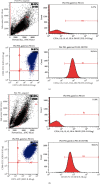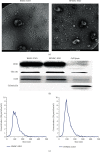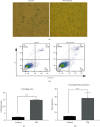Similar Repair Effects of Human Placenta, Bone Marrow Mesenchymal Stem Cells, and Their Exosomes for Damaged SVOG Ovarian Granulosa Cells
- PMID: 33376492
- PMCID: PMC7738794
- DOI: 10.1155/2020/8861557
Similar Repair Effects of Human Placenta, Bone Marrow Mesenchymal Stem Cells, and Their Exosomes for Damaged SVOG Ovarian Granulosa Cells
Abstract
Background: This study is aimed at investigating the repairing effect of mesenchymal stem cells and their exosomes from different sources on ovarian granulosa cells damaged by chemotherapy drugs-phosphoramide mustard (PM).
Methods: In this study, we choose bone marrow mesenchymal stem cells (BMSCs) and human placental mesenchymal stem cells (HPMSCs) for research. Then, they were cocultured with human ovarian granulosa cells (SVOG) injured by phosphoramide mustard (PM), respectively. β-Galactosidase staining, flow cytometry, and Western blot were used to detect the changes in the senescence and apoptosis of SVOG cells before and after their coculture with the above two types of MSCs. Subsequently, exosomes from these two types of MSCs were extracted and added to the culture medium of SVOG cells after PM injury to test whether these two types of exosomes played a role similar to that of MSCs in repairing damaged SVOG cells.
Results: PM treatment-induced apoptotic SVOG cells were significantly decreased after HPMSCs and BMSCs as compared with control group. After coculturing with these two types of MSCs, PM-treated SVOG cells showed significantly reduced senescence and apoptosis proportions as well as cleaved-Caspase 3 expression, and HPMSCs played a slightly stronger role than BMSCs in repairing SVOG cells in terms of the above three indicators. In addition, the ratios of senescent and apoptotic SVOG cells were also significantly reduced by the two types of exosomes, which played a role similar to that of MSCs in repairing cell damages.
Conclusions: The results indicated that BMSCs, HPMSCs, and their exosomes all exerted a certain repair effect on SVOG cells damaged by PM, and consistent repair effect was observed between exosomes and MSCs. The repair effect of exosomes secreted from BMSCs and HPMSCs on the SVOG cells was studied for the first time, and the results fully demonstrated that exosomes are the key carriers for MSCs to play their role.
Copyright © 2020 Shuwen Chen et al.
Conflict of interest statement
The authors declare that they have no competing interests.
Figures










Similar articles
-
Heat shock pretreatment of mesenchymal stem cells for inhibiting the apoptosis of ovarian granulosa cells enhanced the repair effect on chemotherapy-induced premature ovarian failure.Stem Cell Res Ther. 2018 Sep 26;9(1):240. doi: 10.1186/s13287-018-0964-4. Stem Cell Res Ther. 2018. PMID: 30257708 Free PMC article.
-
Unleashing the Impact of Exosomes Derived from Human Placental Mesenchymal Stem Cells (hPMSCs) on U-266 Myeloma Cell Line.Int J Hematol Oncol Stem Cell Res. 2024 Jul 1;18(3):274-284. doi: 10.18502/ijhoscr.v18i3.16109. Int J Hematol Oncol Stem Cell Res. 2024. PMID: 39257702 Free PMC article.
-
Exosomes derived from human placenta-derived mesenchymal stem cells improve neurologic function by promoting angiogenesis after spinal cord injury.Neurosci Lett. 2020 Nov 20;739:135399. doi: 10.1016/j.neulet.2020.135399. Epub 2020 Sep 30. Neurosci Lett. 2020. PMID: 32979457
-
Progress of Mesenchymal Stem Cell-Derived Exosomes in Tissue Repair.Curr Pharm Des. 2020;26(17):2022-2037. doi: 10.2174/1381612826666200420144805. Curr Pharm Des. 2020. PMID: 32310043 Review.
-
Mesenchymal stem cell-derived exosomes: a possible therapeutic strategy for repairing heart injuries.Front Cell Dev Biol. 2023 Jun 30;11:1093113. doi: 10.3389/fcell.2023.1093113. eCollection 2023. Front Cell Dev Biol. 2023. PMID: 37457298 Free PMC article. Review.
Cited by
-
Potential of Mesenchymal Stem Cell-Derived Exosomes as a Novel Treatment for Female Infertility Caused by Bacterial Infections.Front Microbiol. 2022 Jan 27;12:785649. doi: 10.3389/fmicb.2021.785649. eCollection 2021. Front Microbiol. 2022. PMID: 35154028 Free PMC article. Review.
-
Expression of long noncoding RNAs in the ovarian granulosa cells of women with diminished ovarian reserve using high-throughput sequencing.J Ovarian Res. 2022 Oct 29;15(1):119. doi: 10.1186/s13048-022-01053-6. J Ovarian Res. 2022. PMID: 36309699 Free PMC article.
-
The function of exosomes in ovarian granulosa cells.Cell Tissue Res. 2023 Nov;394(2):257-267. doi: 10.1007/s00441-023-03820-3. Epub 2023 Aug 21. Cell Tissue Res. 2023. PMID: 37603064 Review.
-
Single and combined strategies for mesenchymal stem cell exosomes alleviate liver fibrosis: a systematic review and meta-analysis of preclinical animal models.Front Pharmacol. 2024 Jul 31;15:1432683. doi: 10.3389/fphar.2024.1432683. eCollection 2024. Front Pharmacol. 2024. PMID: 39144628 Free PMC article.
-
Bone marrow mesenchymal stem cells in premature ovarian failure: Mechanisms and prospects.Front Immunol. 2022 Oct 27;13:997808. doi: 10.3389/fimmu.2022.997808. eCollection 2022. Front Immunol. 2022. PMID: 36389844 Free PMC article.
References
-
- Tilmann C., Capel B. Mesonephric cell migration induces testis cord formation and Sertoli cell differentiation in the mammalian gonad. Development. 1999;126(13):2883–2890. - PubMed
LinkOut - more resources
Full Text Sources
Research Materials

